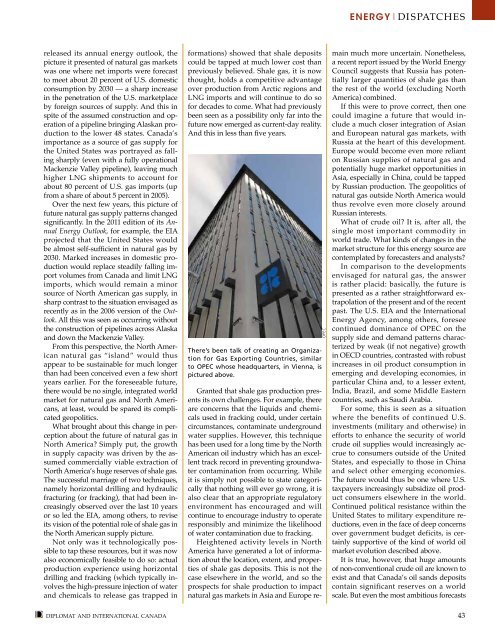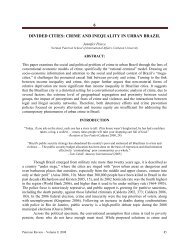the new petro power paradigm - Diplomat Magazine
the new petro power paradigm - Diplomat Magazine
the new petro power paradigm - Diplomat Magazine
You also want an ePaper? Increase the reach of your titles
YUMPU automatically turns print PDFs into web optimized ePapers that Google loves.
ENERGY|Di spatches<br />
released its annual energy outlook, <strong>the</strong><br />
picture it presented of natural gas markets<br />
was one where net imports were forecast<br />
to meet about 20 percent of U.S. domestic<br />
consumption by 2030 — a sharp increase<br />
in <strong>the</strong> penetration of <strong>the</strong> U.S. marketplace<br />
by foreign sources of supply. And this in<br />
spite of <strong>the</strong> assumed construction and operation<br />
of a pipeline bringing Alaskan production<br />
to <strong>the</strong> lower 48 states. Canada’s<br />
importance as a source of gas supply for<br />
<strong>the</strong> United States was portrayed as falling<br />
sharply (even with a fully operational<br />
Mackenzie Valley pipeline), leaving much<br />
higher LNG shipments to account for<br />
about 80 percent of U.S. gas imports (up<br />
from a share of about 5 percent in 2005).<br />
Over <strong>the</strong> next few years, this picture of<br />
future natural gas supply patterns changed<br />
significantly. In <strong>the</strong> 2011 edition of its Annual<br />
Energy Outlook, for example, <strong>the</strong> EIA<br />
projected that <strong>the</strong> United States would<br />
be almost self-sufficient in natural gas by<br />
2030. Marked increases in domestic production<br />
would replace steadily falling import<br />
volumes from Canada and limit LNG<br />
imports, which would remain a minor<br />
source of North American gas supply, in<br />
sharp contrast to <strong>the</strong> situation envisaged as<br />
recently as in <strong>the</strong> 2006 version of <strong>the</strong> Outlook.<br />
All this was seen as occurring without<br />
<strong>the</strong> construction of pipelines across Alaska<br />
and down <strong>the</strong> Mackenzie Valley.<br />
From this perspective, <strong>the</strong> North American<br />
natural gas “island” would thus<br />
appear to be sustainable for much longer<br />
than had been conceived even a few short<br />
years earlier. For <strong>the</strong> foreseeable future,<br />
<strong>the</strong>re would be no single, integrated world<br />
market for natural gas and North Americans,<br />
at least, would be spared its complicated<br />
geopolitics.<br />
What brought about this change in perception<br />
about <strong>the</strong> future of natural gas in<br />
North America? Simply put, <strong>the</strong> growth<br />
in supply capacity was driven by <strong>the</strong> assumed<br />
commercially viable extraction of<br />
North America’s huge reserves of shale gas.<br />
The successful marriage of two techniques,<br />
namely horizontal drilling and hydraulic<br />
fracturing (or fracking), that had been increasingly<br />
observed over <strong>the</strong> last 10 years<br />
or so led <strong>the</strong> EIA, among o<strong>the</strong>rs, to revise<br />
its vision of <strong>the</strong> potential role of shale gas in<br />
<strong>the</strong> North American supply picture.<br />
Not only was it technologically possible<br />
to tap <strong>the</strong>se resources, but it was now<br />
also economically feasible to do so: actual<br />
production experience using horizontal<br />
drilling and fracking (which typically involves<br />
<strong>the</strong> high-pressure injection of water<br />
and chemicals to release gas trapped in<br />
formations) showed that shale deposits<br />
could be tapped at much lower cost than<br />
previously believed. Shale gas, it is now<br />
thought, holds a competitive advantage<br />
over production from Arctic regions and<br />
LNG imports and will continue to do so<br />
for decades to come. What had previously<br />
been seen as a possibility only far into <strong>the</strong><br />
future now emerged as current-day reality.<br />
And this in less than five years.<br />
There’s been talk of creating an Organization<br />
for Gas Exporting Countries, similar<br />
to OPEC whose headquarters, in Vienna, is<br />
pictured above.<br />
OPEC<br />
Granted that shale gas production presents<br />
its own challenges. For example, <strong>the</strong>re<br />
are concerns that <strong>the</strong> liquids and chemicals<br />
used in fracking could, under certain<br />
circumstances, contaminate underground<br />
water supplies. However, this technique<br />
has been used for a long time by <strong>the</strong> North<br />
American oil industry which has an excellent<br />
track record in preventing groundwater<br />
contamination from occurring. While<br />
it is simply not possible to state categorically<br />
that nothing will ever go wrong, it is<br />
also clear that an appropriate regulatory<br />
environment has encouraged and will<br />
continue to encourage industry to operate<br />
responsibly and minimize <strong>the</strong> likelihood<br />
of water contamination due to fracking.<br />
Heightened activity levels in North<br />
America have generated a lot of information<br />
about <strong>the</strong> location, extent, and properties<br />
of shale gas deposits. This is not <strong>the</strong><br />
case elsewhere in <strong>the</strong> world, and so <strong>the</strong><br />
prospects for shale production to impact<br />
natural gas markets in Asia and Europe remain<br />
much more uncertain. None<strong>the</strong>less,<br />
a recent report issued by <strong>the</strong> World Energy<br />
Council suggests that Russia has potentially<br />
larger quantities of shale gas than<br />
<strong>the</strong> rest of <strong>the</strong> world (excluding North<br />
America) combined.<br />
If this were to prove correct, <strong>the</strong>n one<br />
could imagine a future that would include<br />
a much closer integration of Asian<br />
and European natural gas markets, with<br />
Russia at <strong>the</strong> heart of this development.<br />
Europe would become even more reliant<br />
on Russian supplies of natural gas and<br />
potentially huge market opportunities in<br />
Asia, especially in China, could be tapped<br />
by Russian production. The geopolitics of<br />
natural gas outside North America would<br />
thus revolve even more closely around<br />
Russian interests.<br />
What of crude oil? It is, after all, <strong>the</strong><br />
single most important commodity in<br />
world trade. What kinds of changes in <strong>the</strong><br />
market structure for this energy source are<br />
contemplated by forecasters and analysts?<br />
In comparison to <strong>the</strong> developments<br />
envisaged for natural gas, <strong>the</strong> answer<br />
is ra<strong>the</strong>r placid: basically, <strong>the</strong> future is<br />
presented as a ra<strong>the</strong>r straightforward extrapolation<br />
of <strong>the</strong> present and of <strong>the</strong> recent<br />
past. The U.S. EIA and <strong>the</strong> International<br />
Energy Agency, among o<strong>the</strong>rs, foresee<br />
continued dominance of OPEC on <strong>the</strong><br />
supply side and demand patterns characterized<br />
by weak (if not negative) growth<br />
in OECD countries, contrasted with robust<br />
increases in oil product consumption in<br />
emerging and developing economies, in<br />
particular China and, to a lesser extent,<br />
India, Brazil, and some Middle Eastern<br />
countries, such as Saudi Arabia.<br />
For some, this is seen as a situation<br />
where <strong>the</strong> benefits of continued U.S.<br />
investments (military and o<strong>the</strong>rwise) in<br />
efforts to enhance <strong>the</strong> security of world<br />
crude oil supplies would increasingly accrue<br />
to consumers outside of <strong>the</strong> United<br />
States, and especially to those in China<br />
and select o<strong>the</strong>r emerging economies.<br />
The future would thus be one where U.S.<br />
taxpayers increasingly subsidize oil product<br />
consumers elsewhere in <strong>the</strong> world.<br />
Continued political resistance within <strong>the</strong><br />
United States to military expenditure reductions,<br />
even in <strong>the</strong> face of deep concerns<br />
over government budget deficits, is certainly<br />
supportive of <strong>the</strong> kind of world oil<br />
market evolution described above.<br />
It is true, however, that huge amounts<br />
of non-conventional crude oil are known to<br />
exist and that Canada’s oil sands deposits<br />
contain significant reserves on a world<br />
scale. But even <strong>the</strong> most ambitious forecasts<br />
diplomat and international canada 43

















